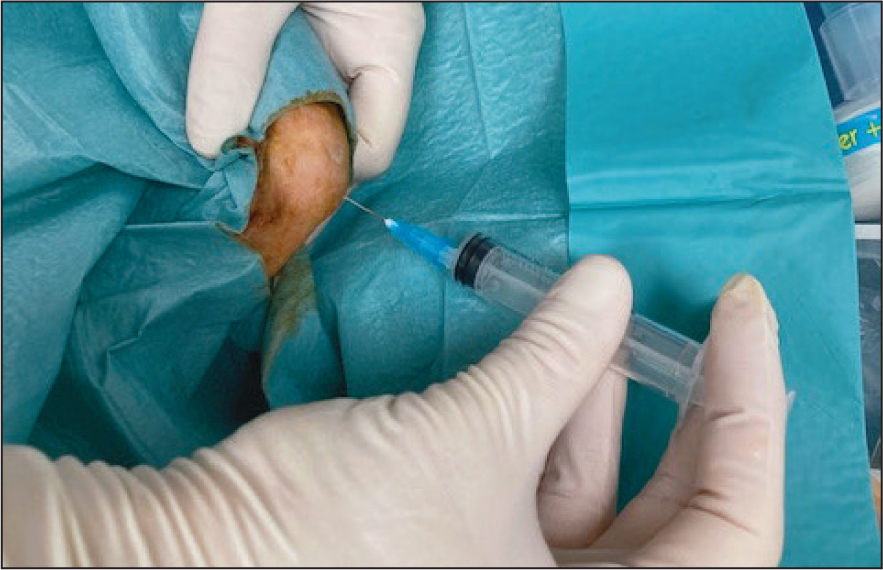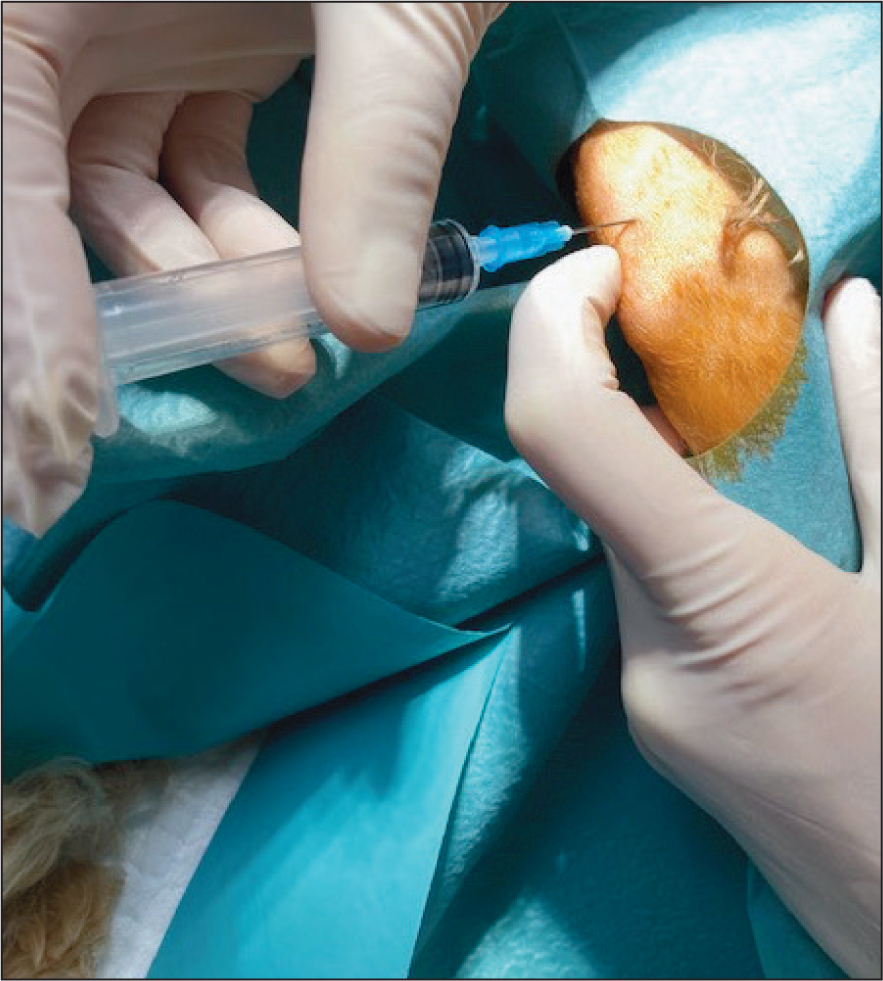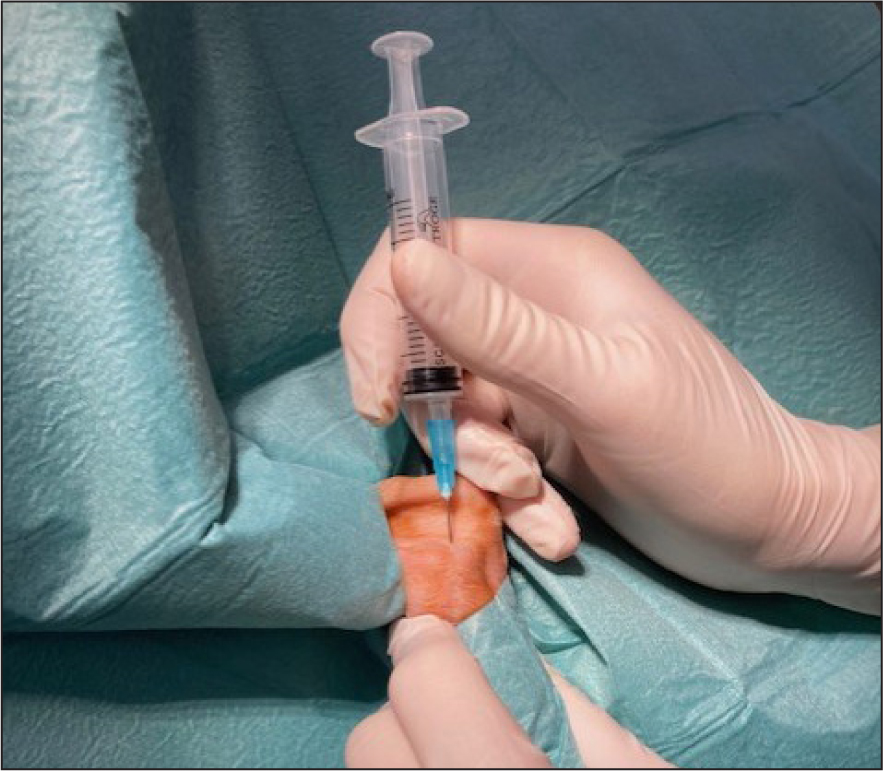‘Immune-mediated polyarthritis (IMPA) is the most common form of inflammatory joint disease encountered in small animal patients’ (Stone, 2016). Before discussing what IMPA is it is important to consider the Greek origin of its title. ‘Polus’ in ancient Greek meaning ‘many or much’ and ‘arthron’ meaning ‘a joint’ allows us to appreciate that multiple joints are affected by this condition (Collins, 2022a; b). IMPA is typically an accumulation of immune complexes in the synovial fluid of a joint, which subsequently draws neutrophils into that space (Specht and Guarino, 2019). The most common presenting complaints of patients with IMPA include: fever, cyclic lethargy, anorexia and a shifting limb lameness. A retrospective study (Clements et al, 2004) identified all dogs with idiopathic IMPA presented with joint stiffness, 22 out of 39 presented pyrexic and 20 out of 39 with a lymphadenopathy. The role of the veterinary team extends beyond the initial diagnosis of the immune-mediated disease, with large involvement in clinical diagnostics, initial treatment and follow-up supportive care for our patients. Similar to the other more commonly seen immune-mediated diseases, such as immune-mediated haemolytic anaemia or immune-mediated thrombocytopenia, investigations should begin promptly to understand if the disease is from a primary or secondary cause in order to treat the patient effectively. IMPA can present as erosive or non-erosive polyarthritis, with only approximately 1% of cases reported to have erosive disease. Because of the marked reduced frequency at which erosive polyarthritis is seen in practice, the remainder of this article will predominantly focus on the non-erosive sub-categories. Commonly presenting clinical signs, diagnostics, initial treatment and follow-up care will be discussed, along with the role of the registered veterinary nurse in nursing the IMPA patient.
Pathophysiology
Non-erosive IMPA is typically induced by a type III hypersensitivity reaction where immune complexes collect in the joint space. Immune complexes are derived from bound antigen–antibody formations and can be identified in the systemic circulation in addition to the joint space. Identifying the trigger of the antigen–antibody formations resulting in the accumulation of immune complexes will allow a directed treatment therapy for the patient. Table 1 demonstrates some of the common clinical examples related to each type of IMPA seen in veterinary patients. Further-more, other immune-mediated diseases can also trigger onset, such as systemic lupus erythematous or steroid responsive meningitis arteritis. It is subsequently the damage within the joint space, due to activation of complement by the presence of immune complexes, that triggers the release of cytokines, drawing neutrophils to the site of injury. This is then heightened by the release of cytokines and lysosomal enzymes from the targeted neutrophils.
Table 1. Clinical examples for each category of immune-mediated polyarthritis
| Type | Clinical examples |
|---|---|
| I | Unidentified trigger – immune-mediated |
| II | Infectious, inflammatory. Underlying infection can include: bacterial, viral, fungal or protozoal. Can be found throughout the body. Non-infectious examples include pancreatitis |
| III | Any gastrointestinal or hepatic disease |
| IV | Neoplasia outside of the joint itself, examples include pancreatic adenocarcinoma, renal carcinoma, squamous cell carcinoma, lymphoma |
Erosive IMPA
Erosive IMPA is extremely rare compared to that of non-erosive IMPA presentations and this disease is often confirmed radiographically with subchondral bone destruction. These changes can take up to 6 months to appear radiographically and can include signs of bone destruction and alterations within the joint space. Rheumatoid arthritis is the most commonly reported form of erosive IMPA and has a significantly more guarded prognosis compared to that of non-erosive forms of IMPA. Radiographic changes, positive agglutination for serum rheumatoid factor and the presence of antibodies directed against immunoglobulins (Ig)M, IgG and IgA, in conjunction with clinical signs, are diagnostic for this disease.
Non-erosive IMPA
Despite idiopathic IMPA being the most commonly seen form of non-erosive IMPA in canine veterinary patients, the registered veterinary nurse should also be aware of the other classifications of this disease and subsequent clinical presentations and relevant patient history. Vaccination- or drug-induced, polymyositis syndrome, steroid-responsive meningitis arteritis and breed-specific arthropathies (Akitas and Shar-peis) have also been reported, and finally systemic lupus erythematosus can cause non-erosive IMPA (Johnson and Mackin, 2012).
Types of IMPA
A disease is referred to as idiopathic when the cause of the condition is unknown or uncertain. In relation to IMPA, this classification is given when all other suggestive underlying causes have been excluded. IMPA has been divided into four subtypes:
- Type I is immune-mediated and as previously mentioned is the most commonly seen in canine patients
- Type II is most commonly associated with infection or reactive disease
- Type III is associated with gastrointestinal or hepatic disease
- Type IV is associated with a neoplastic cause (Merrill, 2012).
Despite these different groupings, the disease is uniform, and the categorisation simply identifies or excludes the presence of concurrent disease processes in the patient.
Clinical signs of IMPA
In patients with cyclic fever of unknown origin, IMPA must be included as one of the key differentials, particularly in the presence of joint pain. Generalised lethargy and stiff gait or limb lameness, localised spine or neck pain are some of the most commonly reported clinical signs. In addition, joint swelling, muscle atrophy, anorexia and peripheral lymphadenopathy are some of the less specific clinical signs. Breed predispositions of this disease include: Labrador Retrievers and German Shepherd Dogs, with patients commonly presenting young to middle-aged (aged 1–6 years).
Diagnostics
Diagnostics, as with any suspected immune-mediated disease, are performed in veterinary patients to exclude any underlying causes. Once underlying causes have been excluded a diagnosis of primary IMPA can be confirmed in conjunction with reported clinical signs.
Multiple arthrocentesis samples are required to confirm this disease, with identified neutrophilic inflammation in more than one joint. Registered veterinary nurses are often heavily involved in the diagnostics for these patients and therefore should have a sound understanding of which tests are being performed, their clinical reasoning, how to perform the tests and interpret the results. Laboratory work should include a comprehensive profile: complete blood count, biochemistry and screening for tick borne-infectious diseases – which can be done in-house via the Idexx 4dx Snap Test (heartworm, Lyme disease, Ehrlichia and Anaplasma) – and clotting times (activated partial thromboplastin time and prothrombin time). Complete blood count changes will often be suggestive of an inflammatory process: eg neutrophilia with a left shift and leucocytosis or leukopenia are reported, whereas the serum biochemistry is usually unremarkable. In cases where corticosteroid therapy has already been started, or the patient is receiving them for a concurrent disease, there may be elevations in liver parameters (alkaline phosphatase or alanine transaminase) (Merrill, 2012). Protein-losing nephropathy or enteropathy may be present because of deposition of immune complexes, which may result in reduced albumin levels with globulin levels increased due to auto-antibody production (Perry, 2015). Further diagnostics will include bi-cavitary imaging such as three-view chest radiographs with abdominal ultrasound or alternatively a full body computerised tomography (CT) depending on the patient's body size. Comprehensive imaging is performed to identify any underlying trigger of disease, for example neoplasia, gastrointestinal changes or areas of focal inflammation or infection. Distal limb radiographs or CT imaging should also be obtained to exclude an erosive disease with the previously mentioned changes commonly seen in patients with erosive IMPA. A urine sample is also collected via cystocentesis (subject to adequate platelet count) to exclude any urinary disease as the trigger. Cystocentesis is the preferred route of sample collection when performing complete urinalysis and culture. The diagnostic investigations are often performed in the sedated or general anaesthetised patient for patient safety and to obtain diagnostic sample quality. The sedation or general anaesthetic plan must be tailored to the individual patient based on signalment, laboratory work, the presence of any underlying disease and concurrent medications the patient may be receiving. This is decided by the veterinary surgeon responsible for the patient or the anaesthesia team within the hospital as appropriate.
Arthrocentesis: the procedure and sample handling
Arthrocentesis is a procedure performed by veterinary surgeons assisted by registered veterinary nurses and can be performed in both first opinion and referral settings when all those involved are familiar with this technique. The aim of the procedure is to obtain synovial fluid from the joint in an aseptic manner for either diagnostic or, in some instances, therapeutic purposes (Merrill, 2012). This procedure is contraindicated in patients with a coagulopathy and sites with signs of overt infection should be avoided.
Arthrocentesis is typically performed at the end of the previously described diagnostic investigations and therefore the patients remain under sedation or general anaes-thetic for this procedure. In the cases where sedation is inadequate for arthrocentesis, commonly conversion to a brief general anaesthetic is performed so that samples can be obtained in an aseptic manner. An important consideration with this aspect of diagnostics is the analgesic requirement of the patients. They have presented with either lameness, joint pain or swelling, lethargy or a combination of these and therefore persistent manipulation of these joints to allow sampling will cause discomfort. As a result of this during the sedation or general anaesthetic, clinical parameter changes such as tachycardia and tachypnoea may be identified. Therefore, in suspected cases of IMPA or when performing arthrocentesis as part of patient diagnostics, this should be pre-empted as part of the anaesthesia and analgesia plan discussed with the veterinary surgeon. Commonly, low-dose opioids, such as methadone or buprenorphine, are often adequate for this procedure with continual patient assessment. Local anaesthetic agents at the site of sampling are not recommended as they increase the risk of contamination to the site and interfere with obtaining only the synovial fluid for analysis (Merrill, 2012).
Sites of sampling can vary among patients and, most commonly, samples are taken from more than one location. The sites most commonly used are those presenting with lameness and inflammation as often these will yield the greatest sample. Examples of some of the most commonly performed sites for arthrocentesis include the carpi dorsal aspect, tarsi dorsolateral aspect, stifle medial aspect, and the elbow caudolateral aspect (Figures 1–3).



The following equipment list should be prepared by the RVN before starting the procedure:
- Sedation or general anaesthetic monitoring equipment
- Emergency intervention equipment (intubation and drugs prepared)
- Clippers
- 4% chlorhexidine scrub solution with gauze swabs
- Sterile chlorhexidine with alcohol final scrub applicator (Chloraprep)
- 2–10 ml syringes
- 22-gauge needles: 5/8 inch for smaller patients and 1 inch for larger
- Sterile gloves
- Sterile fenestrated drape per site of sampling
- Sample collection containers: ethylendiamine tetraacetic acid (EDTA) blood tubes, plain blood tubes, microscope slides, slide container, blood culture pot or sterile charcoal swab for culture, pencil for slide labelling and permanent pen for tube labelling.
Patients are most commonly positioned in lateral recumbency for this procedure and all sites are prepared surgically to include 5x5 cm clip and scrub over the joint or area of needle insertion. The sterile surgeon drapes the selected site and the assistant often restrains limb or prepares the equipment and sample handling accordingly. All joints to be sampled are often prepared at the start of the procedure with the final sterile scrub performed by the registered veterinary nurse immediately before sampling to maintain asepsis. Once synovial fluid is obtained the registered veterinary nurse can prepare the samples for analysis. Synovial air-dried smears can be made, a drop is either placed on the bacteriology swab or placed in the blood culture bottle for culture analysis and the remainder can be placed into EDTA for external cytology. Synovial fluid is clear to straw coloured and is typically viscous. If slide drying time can be reduced with the use of a hair dryer this should be done to decrease risk of slide contamination with prolonged drying and exposure times. It is essential all samples are labelled before moving to the next site to allow an accurate interpretation of each site for diagnosis. This process is repeated in a continued aseptic manner for all other joints for sampling. The main complications that could be seen with this procedure include iatrogenic infection, haemorrhage or cartilage damage at the site. With appropriate patient preparation and sampling technique, the risk of these complications is reduced (Jones, 2020)
Post-procedural considerations
These patients are often in pain on admission and post-procedure and therefore should receive continued analgesic assessment during recovery following arthrocentesis. Despite analgesic intervention, repeated pain assessments should be performed in a timely manner to ensure that the level of intervention for the patient is appropriate. Pain assessment can be subjective and each patient will demonstrate this in different ways. Therefore, to reduce subjectivity minimal personnel should be involved with the patient's assessment and the same pain scale tool should be used for consistency.
Analgesic interventions in these patients often consist of opiates such as methadone (0.1–0.2 mg/kg) intravenously (IV) every 4–6 hours or buprenorphine (0.01–0.02 mg/kg) IV every 6–8 hours (Allerton, 2020a; b). Furthermore, other medications such as ketamine given as a constant rate infusion (approximately 2–5 mcg/kg/min) IV can also be considered in patients with more severe pain (Allerton, 2020c). Additionally, paracetamol may also be considered for analgesic therapy in these patients with 10 mg/kg IV or per os every 8–12 hours according to route of administration and patient need (Allerton, 2020d).
It is important to consider treatment plans based on the working diagnosis in these patients. Patients with a suspected immune-mediated cause of disease will subsequently receive immunosuppressive therapy (steroids) and therefore giving a non-steroidal anti-inflammatory such as meloxicam for analgesia, would be contraindicated in these cases. This is contraindicated due to adverse effects reported on the kidneys, platelets and gastrointestinal tract (Narita et al, 2007).
In addition to pain scoring, generalised patient assessment can help tailor analgesic therapy. For example, is the patient able to eat and drink independently and walk outside to allow appropriate elimination? If the patient struggles it would be an indication at that point that the patient is still in some discomfort and analgesic therapy requires re-assessment. These patients often present pyrexic and therefore although close patient body temperature monitoring under sedation or general anaesthetic is performed, they must not be actively cooled. The pyrexia and pain/joint effusion will resolve in these patients following a confirmed diagnosis of IMPA with subsequent appropriate treatment.
Treatment of IMPA
Treatment of IMPA will include medications targeting the underlying disease (if identified) and treatment of the joint inflammation itself. In cases where no underlying trigger has been confirmed despite extensive investigations, immunosuppression is most commonly the treatment of choice with idiopathic IMPA patients. Prednisolone at immunosuppressive doses (2–4 mg/kg, according to species and clinician preference, per os) daily is often the initial therapy of choice before combination therapy in veterinary patients (McKenna, 2020). Close monitoring must be performed for corticosteroid side effects such as polyuria, polydipsia and polyphagia. The veterinary team are responsible for educating the owner of these adverse side effects and they should be advised to closely monitor following discharge.
In instances where a poor response to treatment is seen or adverse side effects are reported, these patients will then undergo combination or second-line therapy. Examples of these include: azathioprine (contraindicated in feline patients because of bone marrow suppression), ciclosporin, leflunomide and mycophenolate mofetil. In a few instances, surgical treatment may be indicated for the patient with IMPA. Arthrodesis, excision arthroplasty and total joint replacement should be considered as salvage procedures and therefore this is not commonly performed for this disease (Perry, 2015).
Once the patient has been started on immunosuppressive therapy, close monitoring at home and follow up laboratory work should be performed, with repeated arthrocentesis as required. Remission following treatment initiation can vary and often treatment is continued for an additional 3–4 weeks before tapering of immunosuppressive medications. This is done gradually via regular rechecks with the veterinary surgeon and tapered according to clinical signs and presentation.
Conclusions
Nursing the patient with IMPA is a largely multifactorial process where the registered veterinary nurse can greatly impact the patient's hospitalised journey to include discharge and follow up care. The registered veterinary nurse acts as a patient advocate, assesses analgesic requirements, monitors response to treatment and supports the veterinary surgeon during the clinical investigations and diagnostics. A good understanding of the disease itself and the reasoning for performing the investigations is essential, to ensure an accurate diagnosis for the patient and to direct appropriate treatment. As with all diseases in veterinary medicine, each patient will present differently, highlighting the importance of closely monitoring patients and their response to provide the best nursing care tailored to the individual. IMPA can be a rewarding diagnosis when treated promptly, and remission can be achieved allowing patients to return to their ‘normal self’.
KEY POINTS
- A diagnosis of immune-mediated polyarthritis (IMPA) can be made once other possible underlying triggers for disease have been excluded.
- Immune mediated polyarthritis is more commonly seen in young canine patients.
- Cyclic fever, lethargy and limb lameness are the most commonly reported clinical signs of IMPA.
- The registered veterinary nurse is often heavily involved in the diagnostics of these cases, including imaging and arthrocentesis.
- Immunosuppressive therapy is the mainstay treatment of this disease following exclusion of any underlying cause.
- Regular analgesic assessments should be performed in these patients during hospitalisation and following discharge.


